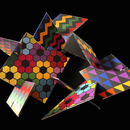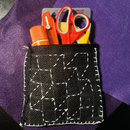Introduction: Designing Afrofuturist Playgrounds: Exploring Geometry Through Creative Urban Planning
This project falls under the category of mathematics + Afrofuturism, a creative practice and thought process that combines science fiction (sci-fi) and fantasy, African diasporic myths, and sociopolitical liberation. Mark Dery, a writer who coined the term in 1994, used his book essay “Black to the Future” to pose the following question:
Can a community whose past has been deliberately rubbed out, and whose energies have subsequently been consumed by the search for legible traces of its history, imagine possible futures?
By the end of this project, students will:
- Apply geometric principles to design an Afrofuturist playground, demonstrating understanding of shapes and their properties.
- Calculate and compare the areas and perimeters of rectangular, triangular, and circular structures within their playground design.
- Analyze the relationship between scale drawings and actual measurements, creating accurate representations of their playground elements.
- Evaluate the effectiveness of their designs in terms of space utilization, accessibility and adherence to geometric principles.
- Create a comprehensive playground plan that integrates Afrofuturist themes with practical geometric applications.
This project is inspired by OX4D Plays that was led by Susan Rogers and the Community Design Resource Center (CDRC) at the University of Houston. The key challenge was to give youth and families the confidence to transform their built environment. The participants used Afrofuturist elements in the designs of different playground experiences.
Supplies
Graph paper (or regular paper) for sketching designs
Rulers and protractors for accurate measurements
Colored pencils or markers for enhancing designs
Compasses for drawing circular structures
Laptops or tablets with internet access for research and for using Tinkercad 3D Design
Projector or smart board for displaying examples and instructions
Handouts for math calculations (PDF)
Tangram shapes (SVG files for importing into Tinkercad)
Examples of Afrofuturist art (PDF)
Calculators for complex calculations (optional)
Tracing paper (optional)
Tape measures for scaling designs to real-world dimensions (optional)
Attachments
Step 1: Explore Afrofuturism
Afrofuturism has a history prior to when the term was coined in the mid-1990s.
Sun Ra was an American jazz composer, bandleader, musician, and poet who developed a mythical persona that made him a pioneer of Afrofuturism. Students can watch his film, Space is the Place to learn more about his work and life, as well as to experience his Afrofuturistic style.
A YouTube video from Vox Magazine offers a primer for students to learn more about Afrofuturism: https://www.youtube.com/watch?v=jlPwTMMhGGI
Shabazz Palaces, an American hip hop group uses Afrofuturist themes in their music and in their album art. This includes "Lese Majesty," which references the spaceship from Space is the Place and uses geometric shapes similar to tangrams, which can help students practice their math problem-solving, and logical thinking skills, sharpen their spatial awareness, and understand how objects relate to the space they're in.
Teachers can display images of Afrofuturistic art using a large screen, or projector (see attached PDF). Next, ask students to observe and discuss the geometric shapes they can identify in the images. Here's a short list of artists who explore Afrofuturistic themes:
Also, New York Public Library has provided a list of Afrofuturism Fiction for Kids, Teens, and Adults: https://www.nypl.org/blog/2021/02/24/afrofuturism-fiction-recommendations
Image credits:
AI-generated Sun Ra portrait by Nettrice Gaskins (2024)
Space is the Place (1974 production still)
Lese Majesty (album art) by Shabazz Palaces
Vox Magazine (video) "Afrofuturism mixes sci-fi and social justice. Here’s how it works."
OX4D Plays (concept map) from Community Design Resource Center (CDRC) at the University of Houston
Attachments
Step 2: Brainstorm Ideas
Afrofuturistic design elements include geometric shapes such as the circle or cosmogram, which is a cultural map that represents the cycle of nature or life as well as a dimensional jump-hole across space and time through which people can move from one world or reality to the next. This figure can be found in cultures around the world including the Navajo Medicine Wheel, the Buddhist Dharmachakra (Dharma wheel or wheel of law), and East Indian rangoli.
The circle/cosmogram can be found in the light cone from special and general relativity, which are physics theories by Albert Einstein that represents the path that a flash of light, traveling in all directions, would take through spacetime.
As a warm up, divide the class into small groups of 3-4 students. Display/project the Spacetime Brainstorming Chart or handout the attached worksheet and provide students with the following questions:
- Where are you in the present moment ("here and now")?
- How does the past influence you?
- What can you do now to influence the future?
Students should take notes and sketch out ideas while they discuss these questions.
Image credits:
Light cone rendering by K. Aainsqatsi via en.wikipedia
Spacetime Brainstorming Chart by Nettrice Gaskins
Medicine Wheel from Native Hope
Dharmachakra (Wheel of the Law) from The Metropolitan Museum of Art
Rangoli for Diwali from Google Arts & Culture
Attachments
Step 3: Design an Afrofuturist Playground
Urban planning is the process of designing a community's physical space to improve the quality of life for its residents. This Instructable was inspired by OX4D Plays, which used Afrofuturist elements in the design of playground experiences.
Students can use their notes/sketches or image references to sketch their own idea(s) for an Afrofuturist playground.
Have students identify the geometric shapes from their sketches. They can use tracing paper to trace their shapes first. Also, if accessible, students can use an AI image generator to assist in this process (see attached).
The Americans with Disabilities Act of 1990 (ADA) prohibits discrimination based on disability. Challenge students to consider design criteria that comply with ADA standards: What can students do to make their playground designs more accessible?
After time is up, have students calculate the perimeter (and area) of the traced/drawn shapes:
- The area and perimeter of the rectangle
- The area and perimeter of the triangle
- The area and circumference of the circle
Attached is a worksheet to help students practice making their perimeter calculations.
Image credit:
AI-generated Afrofuturist playground designs by Nettrice Gaskins
Perimeter graphic by Mashup Math
Attachments
Step 4: Tinkercad 3D Design Challenge
Now that students have explored the basics of Afrofuturist playground design and made some geometric calculations, have them apply these design concepts to 3D modeling.
The playground design process involves determining the purpose, safety and ADA standards of the playground, as well as creating equipment for a specific location. Many of these elements can be modeled using Tinkercad.
Introduce students to Tinkercad 3D Design (tutorials).
Challenge students to create 3D models based on their sketched or use tangram shapes (handout is attached).
Students can import the attached tangram shapes as SVGs into Tinkercad and use them to create their playground designs.
See attached worksheet for more Afrofuturist/tangram playground design + math ideas.
Step 5: From Afrofuturism to Afro-Now-ism
This goal of this Instructable was to show how to combine math and Afrofuturism, as well as understand and explore certain design criteria and constraints.
Designing fun things can be more inclusive. Students can evaluate the effectiveness of their designs in terms of space utilization, accessibility and adherence to geometric principles. Plan at least one gallery walk and peer review during the project and give students time to iterate on the feedback they receive. Students can ask/answer questions such as:
- What things do you see?
- How are 3D design elements and principles used in the project?
- How does the project convey the overall theme?
- Do you like this project? Why or why not? What is the best thing about this project? What can be improved?
Afrofuturist books such as Octavia Butler’s "Parable of the Sower" gives disabled and minority characters the ability to speculate about their lives in the future.
A play on Afrofuturism, Afro-now-ism acknowledges the urgencies of accessibility/disability, racial injustice, climate disaster, and their collisions by forsaking speculation in favor of immediate action.
As part of the design/modeling process have students iterate on their initial Tinkercad 3D designs, using ADA criteria such as:
- Any running slope over 1:20 or 5 percent is treated as a ramp with handrails and landings.
- Design/add lift systems that are large enough to transport riders in wheelchairs or scooters between floors.
See attached examples (images).
Step 6: Exit Ticket
On paper, have students answer the following questions:
a) What was the most challenging part of calculating areas and perimeters for your playground structures?
b) How did using scale drawings help in your design process?
c) Name one way you incorporated Afrofuturism into your playground design.
d) What ADA accessibility/disability criteria, if any, did you include in your design?
Image credit:
This project is an artifact of Culturally Relevant Math Expressions created with Lesley STEAM Learning Lab at Lesley University and made possible by the generous support of Takeda US CSR & Philanthropy.








